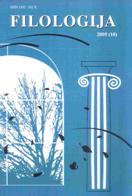Lietuvių tekstilės terminai somatizmai ir zoomorfizmai
Somatisms and Zoomorphisms in Lithuanian Textile Terminology
Author(s): Dalia EigirdienėSubject(s): Language and Literature Studies
Published by: VšĮ Šiaulių universiteto leidykla
Keywords: somatisms; zoomorphisms; textil terminology; diminutives; emotional connotation
Summary/Abstract: Textile terms in Lithuanian dialects come from different layers of vocabulary. The majority of Lithuanian textile terms are the words from other spheres. Small groups of words the meaning of which are body parts: blaũzdos „legs“, keñklės „back side of the knee“, kiñkos „legs“, kójos „legs“, kùlšys „legs“, krūtìnė „chest“, liemuõ „waist“, meñtė „shoulder-blade“, rankẽlės „hands“ (dem.), ríetai „thighs“, stuomuõ „body part from the neck to the feet“, širdìs „heart“, šlaũnys „thighs“, šónai „backs“, žandaĩ „cheeks“ and names of animals: gaidùkas „rooster“ (dem.), kumẽlė „mare“ (dem.), lapẽlė „fox“ (dem.), ožiùkas „goat“ (dem.), šunỹčiai „puppies“ (dem.), vanagẽlis „hawk“ (dem.) can be distinguished among them. The article deals with the occurrence of zoomorphisms and somatizms in Lithuanian textile terminology. The usage of zoomorphisms and somatisms in Lithuanian textile terminology is not evenly distributed. Among those more frequently used terms denoted external body parts should be mentioned. Wide usage of diminutives could be explained by a positive emotional connotation of a Lithuanian weaver. Somatisms are more widely spread in the textile terminology than zoomorphisms. Majority of them denote parts of a weaving loom and a spinning wheel according to the function (mentioned groups blaũzdos, kiñkos, kójos, etc.), while others according to the form (krūtìnė, mentẽlė, ožỹs, širdìs, etc.). Some terms, for example, gaidùkas, lapẽlė, žandaĩ, etc. could not be attributed to any of the above and their motivation in terminology could hardly be explained. The secondary usage of the above terms is thought to be older than special new derivatives.
Journal: Filologija
- Issue Year: 2005
- Issue No: 10
- Page Range: 27-30
- Page Count: 4
- Language: Lithuanian

